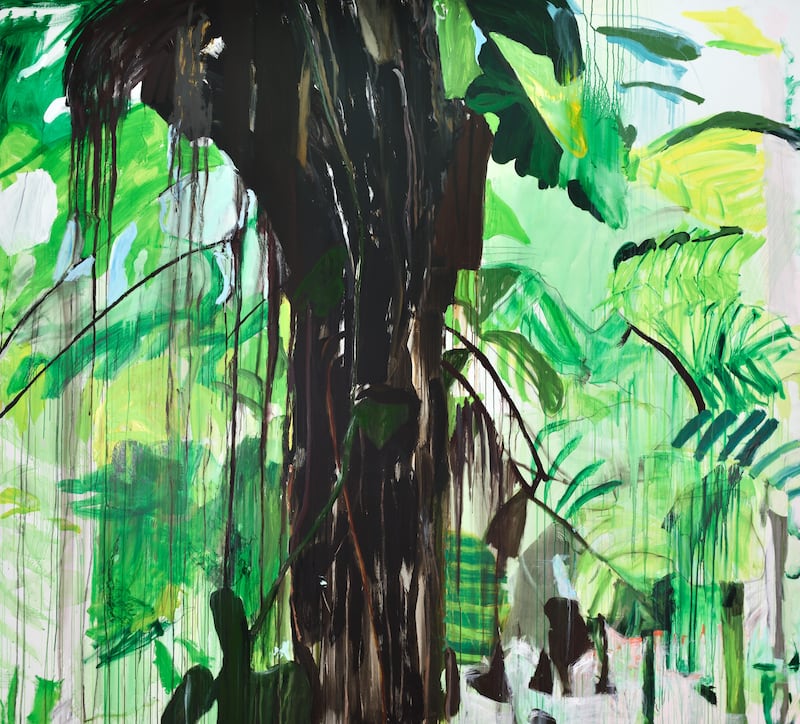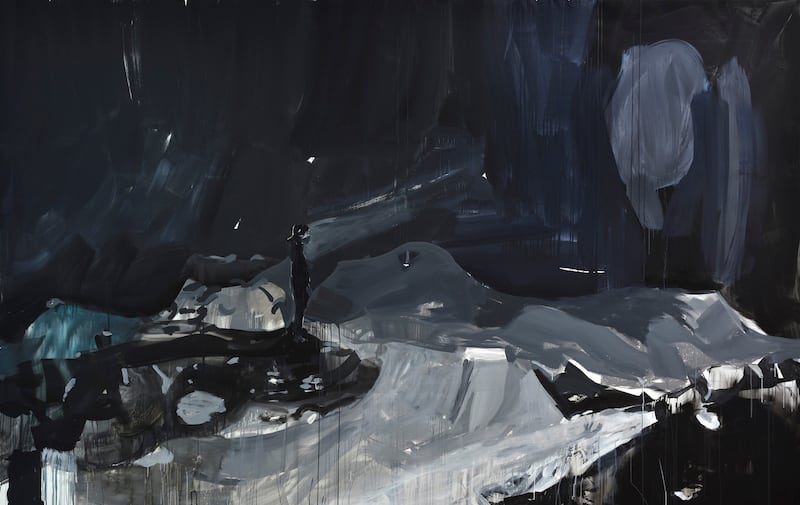Not for Brian Maguire the easeful life of painting official portraits, or doing commissions for wealthy patrons. Now in his 73rd year, the Wicklow-born artist is still travelling the world, pursuing a lifelong quest to illustrate injustice and to put a face on misery in the notorious hubs of human suffering.
Having worked in South Sudan, Syria and and Mexican city of Juárez, he travelled to Brazil in April 2022 to study the accelerating destruction of the Amazonian rainforest. Maguire visited five remote villages by boat and met with the Maraguá people, whose fishing grounds are being destroyed by mining companies. The resulting large-scale canvases will feature in a new exhibition at the Kerlin Gallery in Dublin. The title, The Clock Winds Down, comes from a Christy Moore song.
Maguire was accompanied by a small group, including a photographer and a community worker. They met with Everaldo Castro, the senior leader of the Maraguá based in Manaus, capital of the state of Amazonas. At each of the five villages they held a listening meeting.
“The Maraguá nation consists of about 1,600 people living on the rivers, with some also in Manaus,” Maguire explains. “We travelled through Autazes and took a boat to Nova Olinda do Norte, where we met the Maraguá in the Baixo Rio Madeira. We were now 150 miles from Manaus.
READ MORE
“We went in very small boats along the Curupira and the Abacaxis – both tributaries of the Madeira river, which is in turn a tributary of the Amazon.
“Through the listening sessions, we were able to get a grasp on the difficulties the Maraguá had under the then government of Jair Bolsonaro, which included the high-level looting of the school-dinner-programme budget, the absence of any medical service in the village or ambulance service to the city, the abuse by the paramilitary police including murder, the imposition by Canadian mining companies whose work will damage beyond repair the fishing grounds that the village depends on, and the lack of deeds of ownership to the 990,000 hectares that comprises the land of this small indigenous nation.”
The primary demand of the five villages, Maguire says, is for their land to be recognised legally. “Currently, the mafia can burn timber, and when it becomes farmland anyone can register the land deeds. So you have a process by which the illegal is the route to the legal.
“The second most common demand is for healthcare. There is none available. In summer, the sick person must be carried, by hand, tens of kilometres to a place where a doctor can be accessed.”
I took from these men the challenge to go and look at the effect of the destruction on the indigenous people
The artist was encouraged to travel to the Amazon by the British journalist Ed Vulliamy, who had asked “What am I doing with the war on the world?”, and by Pat Clarke, a Dublin priest and activist in São Paulo who put him in touch with Simi, a Catholic NGO in Manaus. “I took from these men the challenge to go and look at the effect of the destruction on the indigenous people,” Maguire says.

In contrast to the rubble of Aleppo, whose bleached buildings with their bullet holes, bombed-out windows and irregular shapes he so memorably portrayed in the 2018 exhibition War Changes Its Address, the Amazonian rain forest would seem to offer a pleasant backdrop. But, of course, Maguire’s mission isn’t to paint pretty pictures. One of the works in The Clock Winds Down depicts fire ripping through the rainforest, which it does with increasing frequency. In 2019, the Brazilian government’s satellite agency counted 74,000 fires in the Amazon, up 84 per cent on the previous year. The scientific journal Nature reported in July 2021 that fires in some sections of the Amazon Basin now produce more carbon dioxide than the surrounding vegetation is able to absorb.
What Maguire does is a form of photojournalism, using a canvas rather than film. This is not a dispassionate documenting of what he sees, though; he is essentially a political activist. In his show Remains at the Crawford Gallery in Cork two years ago, he depicted the unfortunates who die every year trying to cross the US-Mexico border by trekking across the Sonoran Desert. The paintings implicitly criticised US immigration policy, with his subjects portrayed as the victims of an uncaring administration.
[ 2022: Damage to Amazon difficult to reverse, even if Bolsonaro is voted outOpens in new window ]
In Brazil, Maguire was all too aware of the blame being attached to Bolsonaro for the accelerating deforestation and fires in the Amazon Basin, as his government reduced satellite monitoring and promoted farming and mining on protected land.
“I was told by friends in São Paulo that in the final weeks before the inauguration of Lula [on January 1st], Bolsonaro told the illegal miners to do their worst,” the artist says. “Lula took 30 million people out of poverty during his first two administrations. Bolsonaro put the 30 million back into poverty, allowed and encouraged deforestation, and refused legal support for the delineation of indigenous land. In his first week, Lula committed to delineating, in law, the boundaries of the indigenous nations.”
Another of the paintings shows a child scavenging for food in the dumps outside of São Paulo, which Maguire actually witnessed in 2003. The connection is that Amazonian communities whose homes and villages are destroyed through land clearance might find themselves pushed into urban deprivation.
“When we returned to Manaus, we had meetings with two groups of Maraguá who live in the city,” Maguire says. “Like in all our cities, there is an underclass that provides employment to youth in the drug distribution business, and the risk exists that Maraguá teenagers can get caught up in this.”
As you’d expect, his interactions with local people are based on equality and co-operation. There is no hint of exploitation, of using suffering for spectacle or personal aggrandisement. Maguire offers art classes to local children, including in Aleppo, and does portraits in pairs, giving one to the sitter.
Most work is an exchange. You have to give something back
“It’s trying not to take without giving,” he once explained. The system was seen in action in the 2013 documentary Blood Rising, directed by Mark McLoughlin, about the “feminocidio” in Juárez, the abduction and murder of hundreds of women. Maguire painted portraits of some of the victims from photographs supplied by grieving families. “Most work is an exchange,” he says in the film. “You have to give something back.”
What he invariably gives back is international recognition for the stories of those he has painted, through exhibitions staged in North, South and Central America; and in Norway, France, Britain and Belgium. He has chronicled conditions in a refugee camp in South Sudan, and worked with the residents of favelas in Brazil. He has painted prisoners in Ireland – having taught in Portlaoise from 1985 to 2011 – but also female inmates at the Bayview Correctional Facility in the Chelsea district of New York City.
His next major exhibition is due to be a series of portraits of missing and murdered indigenous women in Montana, a continuation of the theme he covered in Juárez. Though he lives between Dublin and Paris, Maguire is a regular visitor to the town of Hope, Idaho which was what led staff at the Missoula Art Museum to ask for help with a project on the missing women. Missoula is near two Native American reservations, and Maguire took up a four-month residency at the museum to do the work.
According to its website, “he has applied his subtle, sensitive humanitarian approach to the plight of Missing and Murdered Indigenous People by meeting with the families of the missing individuals”.

On November 7th, 1984, Maguire, along with the artists Patrick Graham, Patrick Hall and Michael Kane, wrote a letter to The Irish Times taking issue with the critic Brian Fallon, who had characterised them as the “angry men of Irish art”. The quartet was presumably rejecting any equivalence with the “angry young men” of British letters, who were famously disillusioned with their society. “Far from miming art trends,” the letter thundered, “the undersigned have followed their own intellectual, intuitive and philosophical path, culminating in their own individual aesthetic response such a realisation of self brings.”
Fallon was hardly wrong to describe Maguire as angry, but it is a controlled and coherent anger. His aim is to tell the biggest stories of his time. It was what prompted him to do a series of paintings about the Mediterranean migrant crisis of 2016, which included working from news photographs but also a road trip to Greece so he could examine in person the conditions experienced by refugees.
A characteristic Maguire shares with photojournalists, he has said, is actually going to where the story is. “It doesn’t work unless you do that. There’s something about sharing a space with the people who are there that enables you to have ownership of the images.”
War, migration and murder: Maguire has told all these stories powerfully. Now he has turned his gaze and his anger on the social and ecological fallout from the destruction of the Amazonian rainforest. It is time for us to look and be angry too.
The Clock Winds Down opens at the Kerlin Gallery, Dublin, on Friday, March 3rd, and runs until Wednesday, April 8th

















